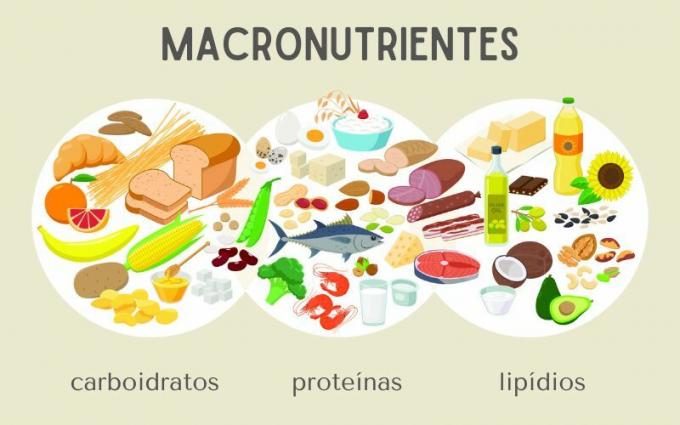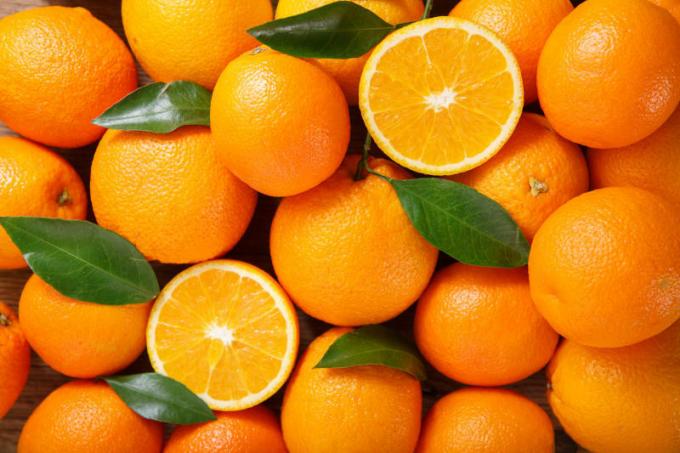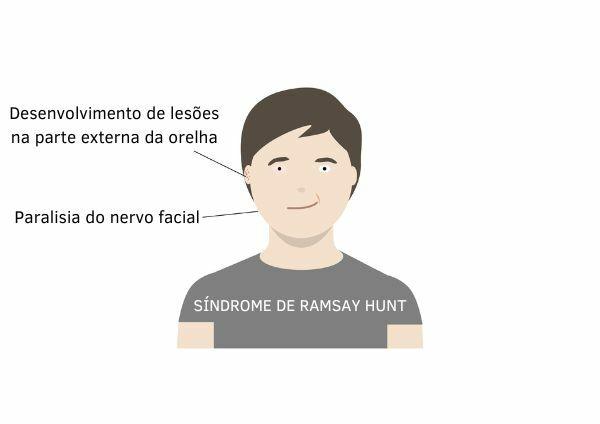You nutrients are substances obtained from food. They are essential for maintaining the body's vital functions, as they provide energy, regulate metabolic pathways and make up the structure of the body. Nutrients are divided into macronutrients and micronutrients, and there are six classes of them, which are distributed in this division: proteins, lipids, carbohydrates, water, mineral salts and vitamins.
Nutrients are ideally obtained when consuming a balanced diet, as each food contains a specific amount of them. The nutritional table is a tool that helps us understand the nutrient composition of each food and, therefore, make conscious choices regarding food.
Read too: What organs are involved in the digestion of food?
Nutrient Summary
- Nutrients are substances found in food that participate in various vital functions of the body.
- They are divided into macronutrients and micronutrients.
- There are six classes: carbohydrates, lipids, proteins, vitamins, minerals and water.
- Lipids and carbohydrates provide energy for the body.
- Vitamins and minerals are important components of metabolic pathways.
- Proteins play an important structural role.
- The nutritional table provides an overview of the nutrients that make up a given food.
What are Nutrients?
the nutrients are chemical substances found in food that are necessary to sustain basic body functions. When we eat food, the digestion process breaks it down into smaller particles, which can be absorbed by the body and used for various purposes.
There are six classes of nutrients essential for human health:
- carbohydrates;
- lipids;
- proteins;
- vitamins;
- minerals;
- water.
Each of these nutrients performs unique and essential functions for the proper functioning of the body.
What is the role and importance of nutrients?
the nutrients act by providing energy for the proper functioning of numerous vital activities of the body. They also collaborate in regulating different functions and metabolic cascades in the body. Furthermore, the nutrients participate in the structural composition of several body structures, contributing to the formation and maintenance of body tissues. In this way, they are vital components of our food, ensuring the health and proper functioning of the body as a whole.
See too: What is the importance of water for our body?
What are the types of nutrients?
Nutrients can be divided into two main groups: macronutrients and micronutrients.
→ Macronutrients
The macronutrients are those that our body needs in greater quantity and are found in abundance in food. They include proteins, carbohydrates, lipids and water.

- Proteins: are organic molecules made up of simpler units called amino acids. They play an important structural role, being the basic raw material of cell structure and promoting the construction and repair of body tissues. Furthermore, they act as a source of energy when stores of lipids and carbohydrates are depleted. Proteins also act as enzymes, components that facilitate chemical reactions in the body. To learn more about proteins, click here.
- Carbohydrates: are the most abundant organic molecules in nature and are the body's main source of energy. They are classified, by the number of subunits, into monosaccharides, disaccharides and polysaccharides. According to their chemical structure, can be classified into simple or complex.. Glucose is a simple carbohydrate and is the main carbohydrate used by the body for energy.
It is obtained through the digestion of foods with complex carbohydrates, which are broken down, resulting in glucose. When consumed in excess, the energy from carbohydrates not consumed is accumulated in the form of lipids, which can contribute to weight gain. Learn more about carbohydrates by clicking here.
Curiosity: Glucose and other complex carbohydrates are known as sugars because of their sweet taste.
- Lipids: are molecules popularly known as fats and oils, being sparingly soluble in water. They are part of cell membranes, act in maintaining body temperature, participate in production of some hormones, aid in the absorption of fat-soluble vitamins, and protect the organs from impacts. Furthermore, act as a source of energy in the absence of available carbohydrates. Its consumption is recommended in moderation. To learn more about lipids, click here.
- Water: molecule present in all foods, but which varies in percentage depending on each one. It acts in the transport of substances, participates in chemical reactions, helps regulate body temperature, acts as a solvent and helps eliminate substances from the body.

→ Micronutrients
On the other hand, micronutrients are needed in low concentrations to ensure the proper functioning of the body. Found in smaller amounts in foods, micronutrients include vitamins and minerals.
- mineral salts: they are inorganic nutrients with different actions in the body depending on the mineral. O iron, for example, is a component of hemoglobin. already the potassium, together with the sodium, helps regulate the amount of water in the body. Other examples of minerals are:chlorine, iodine, fluorine, magnesium and calcium. To learn more about the importance of these nutrients, click here.

- Vitamins: they are organic nutrients that regulate various activities in the body depending on the type of vitamin, and their absence or excess has an impact on the well-being of the body. Vitamin C acts in collagen production and iron absorption. Vitamin D, in turn, aids in the absorption of calcium. Vitamins can be classified as water-soluble (vitamins B and C, for example) and liposoluble (vitamins A, D, E and K, for example). Learn more about vitamins in foods by clicking here.

What are the most important nutrients?
It is important to emphasize that, despite the distinction in macro and micronutrients, none of them is more important than the otherin food. Both must be consumed to achieve a balanced diet and ensure the proper functioning of the body.
Furthermore, there is no food that contains all the nutrients necessary for the proper functioning of the body, requiring a diversified diet to obtain them. In that regard, focus on a “colorful” diet during meals can help to obtain a greater diversity of nutrients.
Main sources of nutrients
Nutrient |
Nutrient source in food |
Proteins |
Meat Egg white milk and derivatives Bean Pea Lentil Chickpea |
carbohydrates |
Potato Rice Corn Cassava Pastas Breads |
lipids |
Margarine Oil Oil Nut |
Water |
Carrot Melon Watermelon Tomato |
mineral salts |
banana (potassium) Red meat (iron) Milk (calcium) Fish and seafood (iodine) Pumpkin Seed (Magnesium) |
Vitamins |
Red meat (vitamin B12) Kale (vitamin K) Orange (vitamin C) Carrot (vitamin A) Fatty fish (vitamin D) Vegetable oils (vitamin E) |
How to know the amount of nutrients in food?
The nutritional table is a set of information that reveals the composition of a food, providing data on the nutrients present, the amount of each per serving and its relation to the recommended daily intake. Thus, this tool becomes fundamental for us to understand the foods we consume and to plan a balanced diet.
In Brazil, it is mandatory that all industrialized products bring a nutritional table in their packages. This requirement is guaranteed by the National Health Surveillance Agency (Anvisa), which regulates the labels of products sold in the country. This measure aims to provide consumers with greater transparency about what they are ingesting, encouraging the adoption of more conscious choices in relation to food.
Check out an example of a nutritional table:
|
Avocado nutritional information* Quantity per 100g |
Daily Values** |
|
calories |
160 kcal |
8% |
Water |
~73g |
- |
carbohydrates |
9 g |
3% |
Proteins |
2 g |
4% |
fats |
15 g |
23% |
fibers |
7 g |
28% |
Vitamin B6 |
0.257 mg |
15% |
Vitamin C |
10mg |
16% |
Potassium |
485 mg |
13% |
Magnesium |
29 mg |
7% |
Sodium |
7 mg |
0% |
*g = gram; kcal = kilocalorie; mg = milligram.
** Based on a 2000 kilocalorie diet.
Know more: Food pyramid — which foods to choose and how much to eat
Examples of nutrients found in some foods
Check out the main nutrients present in some of the most consumed foods in Brazil:
- Rice (cooked): carbohydrates, protein, fiber*, B vitamins (especially B1 and B3), iron and magnesium.
- Bean (black, carioca and other types): proteins, fibers, carbohydrates, iron, magnesium and potassium.
- Milk (whole or skimmed): protein, calcium, vitamin D, vitamin B12, phosphorus and potassium.
- Egg (cooked or fried): protein, healthy fats, choline, vitamin B12, vitamin D, selenium and iron.
- Cabbage (braised or raw): vitamin A, vitamin C, vitamin K, calcium, iron, magnesium and fiber.
- Chicken (cooked or grilled): protein, B vitamins (especially B3 and B6), phosphorus and selenium.
- Banana: carbohydrates, fibers, vitamin C, vitamin B6, potassium and manganese.
- Carrot (raw or cooked): vitamin A, vitamin K, vitamin B6, potassium and fiber.
Observation: To the plant fibers traditionally not considered to be a nutrient because they are not digested by the human body. Despite this, together with water consumption, they play an important role in maintaining the proper functioning of the intestine and are usually present in nutritional tables.
Sources
ALBERTS, B et al. Molecular Biology of the Cell. 6 ed. New York: Garland Science, Taylor and Francis Group, 2015. 1464 p.
CHEN, Y. et al. Importance of Nutrients and Nutrient Metabolism on Human Health. Yale J Biol Med. 2018. 91(2): 95–103.
UNITED STATES DEPARTMENT OF AGRICULTURE (USDA). FoodData Central. In: USDA. Available in: https://fdc.nal.usda.gov/fdc-app.html#/food-details/167765/nutrients.
MORRIS, A.L. & MOHIUDDIN, S.S. Biochemistry, Nutrients. In:StatPearls. Treasure Island (FL): StatPearls Publishing. 2023. Available in: https://www.ncbi.nlm.nih.gov/books/NBK554545/.
UNIVERSITY OF SÃO PAULO (USP) & FOOD RESEARCH CENTER (FoRC). Brazilian Food Composition Table (TBCA). Version 7.2. Available in: http://www.fcf.usp.br/tbca.


